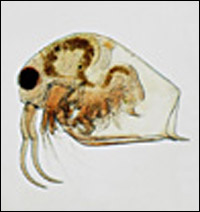Finally, Male Water Fleas Exposed

This male water flea of Bosmina genus debuted in a UB lab.
Male water fleas that scientists have never seen have made their debut in a University at Buffalo laboratory, providing biologists with their first glimpse of these elusive organisms.
The UB research, published last month in Proceedings of the Royal Society: Biological Sciences, opens a new window on the biological diversity of several species of water fleas, including those in the genus Daphnia and the genus Bosmina, that play major roles in freshwater food webs.
It also demonstrates that pesticides that mimic the hormone used in the UB experiments may have much broader effects than initially believed, and could damage populations of fish and other organisms higher up in the food chain.
“Most freshwater fish eat water fleas at some point in their lives,” said Derek J. Taylor, Ph.D., associate professor of biological sciences in UB’s College of Arts and Sciences and co-author on the paper. “They are an important food source for fish.”
Water fleas are nearly microscopic organisms with transparent bodies. Found in lakes, ponds and other bodies of fresh water, they are crustaceans like lobsters and not insects, as their name suggests.
“People use water fleas as aquatic ’coal-mine canaries,’” said Taylor. “They are good indicators of environmental change.”
In stable environments, female water fleas generally reproduce asexually, essentially cloning themselves and resulting in populations of females that are practically impossible to tell apart.
Water flea populations grow much faster when they reproduce asexually than when they do so sexually, Taylor explained.
He added that the practice of rarely producing males has likely been conserved for 100 million years or more in a large group of freshwater crustaceans.
In the UB experiments, four distantly related species of water fleas were exposed to methyl farnesoate (MF), a crustacean juvenile hormone that is known to determine sex in some species that regularly produce males.
The researchers found that the MF exposure caused the production of males in different families of water fleas, despite the fact that they were only distantly related to each other and despite the fact that laboratory conditions were designed to be unfavorable to the production of males.
“Because the same MF hormone affects a broad range of crustaceans, any insecticide that mimics MF also may affect a large number of species in freshwater communities,” said Taylor.
“In other words, MF-based insecticides are not insect-specific, and if you affect a non-target species that’s a major player in these freshwater food webs, then it will affect things higher up the food chain,” he said.
The increased production of males after exposure to these insecticides could reduce water flea populations significantly, adversely affecting freshwater fish populations, he said.
The induction of males in the lab comes at an important time, Taylor explained, since the Daphnia genome is expected to be published next year. Taylor is a member of the consortium based at Indiana University that is working on the genome.
“Breeding studies with both males and females often are necessary to identify candidate genes responsible for certain genetic traits,” Taylor said. “If we want to understand, for example, the genetic basis for why some clones of Daphnia from lakes are more resistant to pollution, then having males could help to find the genes in the genome.”
Male water fleas, Taylor explained, are assigned more readily to a species than are females, but males are only rarely produced and for many species, have never been seen.
“We need to know the species identities in order to understand how freshwater communities are changing over time, as a response to climate change, pollution or invasive species,” said Taylor. “We’re hoping that by studying the biology of the rare males, we can learn more about species diversity and freshwater ecosystem changes.”
The male-inducing tool now will be used to understand water flea species diversity on a global scale.
Co-authors on the paper are Keonho Kim, doctoral candidate in the UB Department of Biological Sciences, and Alexey A. Kotov, Ph.D., scientist at the A. N. Severtsov Institute of Ecology and Evolution, Russian Academy of Sciences in Moscow.
The research was supported by a grant from the National Science Foundation, “Partnership for Enhancing Expertise in Taxonomy.”
The University at Buffalo is a premier research-intensive public university, the largest and most comprehensive campus in the State University of New York.
Media Contact
More Information:
http://www.buffalo.eduAll latest news from the category: Life Sciences and Chemistry
Articles and reports from the Life Sciences and chemistry area deal with applied and basic research into modern biology, chemistry and human medicine.
Valuable information can be found on a range of life sciences fields including bacteriology, biochemistry, bionics, bioinformatics, biophysics, biotechnology, genetics, geobotany, human biology, marine biology, microbiology, molecular biology, cellular biology, zoology, bioinorganic chemistry, microchemistry and environmental chemistry.
Newest articles

Superradiant atoms could push the boundaries of how precisely time can be measured
Superradiant atoms can help us measure time more precisely than ever. In a new study, researchers from the University of Copenhagen present a new method for measuring the time interval,…

Ion thermoelectric conversion devices for near room temperature
The electrode sheet of the thermoelectric device consists of ionic hydrogel, which is sandwiched between the electrodes to form, and the Prussian blue on the electrode undergoes a redox reaction…

Zap Energy achieves 37-million-degree temperatures in a compact device
New publication reports record electron temperatures for a small-scale, sheared-flow-stabilized Z-pinch fusion device. In the nine decades since humans first produced fusion reactions, only a few fusion technologies have demonstrated…





















